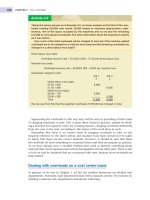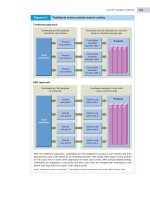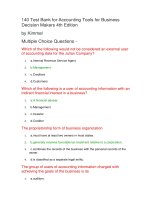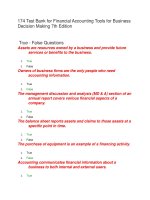Managerial economics economic tools for todays decision makers 7th edtion by keat young and erfle chapter 02
Bạn đang xem bản rút gọn của tài liệu. Xem và tải ngay bản đầy đủ của tài liệu tại đây (168.21 KB, 36 trang )
Chapter 2
The Firm
and Its Goals
Chapter Outline
• The firm and resource allocation
• Profit maximization- the economic goal of the
firm
• Goals other than profit
• Do companies maximize profits?
• Maximizing the wealth of stockholders
• Economic profit
Copyright ©2014 Pearson Education, Inc. All rights reserved.
2-2
Learning Objectives
• Understand the reasons for the existence of
firms and the meaning of transaction costs
• Explain the economic goals of the firm and
optimal decision making
• Describe the ‘principal-agent’ problem
• Distinguish between “profit maximization”
and the “maximization of the wealth of
shareholders”
• Demonstrate the usefulness of Market Value
Added® and Economic Value Added®
Copyright ©2014 Pearson Education, Inc. All rights reserved.
2-3
The Firm
• A firm is a collection of resources that is
transformed into products demanded by
consumers
• Profit is the difference between revenue
received and costs incurred
Price x Unit sold = Revenue –Costs = Profit
Copyright ©2014 Pearson Education, Inc. All rights reserved.
2-4
The Firm
• Why does a firm perform certain functions
internally and others through the market?
• Transaction costs are incurred when entering
into a contract.
– Types of transaction costs:
• investigation
• negotiation
• enforcing contracts
Copyright ©2014 Pearson Education, Inc. All rights reserved.
2-5
The Firm
• Transaction costs are incurred when entering
into a contract
– Influences
• uncertainty
• frequency of recurrence
• asset specificity
Copyright ©2014 Pearson Education, Inc. All rights reserved.
2-6
The Firm
• Examples of transaction costs
– Offshoring to source consumer products
(e.g. retail stores)
– Manufacturing components overseas (e.g.
the automotive industry)
– Logistics services (e.g. warehousing,
delivery, etc.)
Copyright ©2014 Pearson Education, Inc. All rights reserved.
2-7
The Firm
• Limits to firm
size
• tradeoff between
external
transactions and the
cost of internal
operations
• company chooses to
allocate resources so
total cost is
minimized (for a
given level of
output)
• outsourcing of
peripheral, non-core
activities
Copyright ©2014 Pearson Education, Inc. All rights reserved.
2-8
The Firm
• Reshoring: Operations returning to the
country where the offshoring occurred
(Example - United States)
• Signs of Reshoring
– Wages in developing countries have been rising.
– The decrease in the value of the dollar has increased the
cost of importing.
– Increases in energy costs have made it more expensive to
ship products
– Manufacturing firms have significantly increased
productivity making firms production more competitive.
Copyright ©2014 Pearson Education, Inc. All rights reserved.
2-9
The Firm
• Illustration: Coase and the Internet
– Ronald Coase wrote in 1937, pre-internet,
but his ideas are still relevant today.
– He discussed tradeoff between internal
costs and external transactions.
– Technology has reduced search costs
improving efficiency.
Copyright ©2014 Pearson Education, Inc. All rights reserved.
2-10
Economic Goal of the Firm and
Optimal Decision Making
• Profit maximization hypothesis: the primary
objective of the firm (to economists) is to
maximize profits
– Other goals include market share, revenue growth, and
shareholder value
• Optimal decision is the one that brings the
firm closest to its goal
– It is crucial to be precisely aware of a firm’s goals. Different
goals can lead to very different managerial decisions given
the same, limited amount of resources.
Copyright ©2014 Pearson Education, Inc. All rights reserved.
2-11
Goals other than Profit
• Economic/financial objectives
– market share, growth rate
– profit margin
– return on investment, return on assets
– technological advancement
– customer satisfaction
– shareholder value
Copyright ©2014 Pearson Education, Inc. All rights reserved.
2-12
Goals other than Profit
• Non-economic objectives
– Good work environment for employees
– Quality products and services for customers
– Good corporate citizenship and social responsibility
Copyright ©2014 Pearson Education, Inc. All rights reserved.
2-13
Do Companies Maximize Profit?
• Argument against companies not maximizing
profits but instead merely aim to satisfice,
which means firms seek to achieve a
satisfactory goal--one that may not require
the firm to ‘do its best’.
Copyright ©2014 Pearson Education, Inc. All rights reserved.
2-14
Do Companies Maximize Profit?
– Two forces leading to satisficing
• position and power of stockholders
• position and power of management
Copyright ©2014 Pearson Education, Inc. All rights reserved.
2-15
Do Companies Maximize Profit?
• Position and power of stockholders
Reasons for satisficing by companies
• larger firms are owned by thousands of
shareholders
• stockholders generally own only minute
interests in the firm and hold diversified
holdings in many other firms
Copyright ©2014 Pearson Education, Inc. All rights reserved.
2-16
Do Companies Maximize Profit?
• Position and power of stockholders
– Stockholders are concerned with performance of their
entire portfolio and not individual stocks
– Stockholders are much less informed about the firm than
management
Thus, stockholders are not likely to take any
action if earning a ‘satisfactory’ return.
Copyright ©2014 Pearson Education, Inc. All rights reserved.
2-17
Do Companies Maximize Profit?
• Position and power of management
– high-level managers may own very little of the firm’s stock
– managers tend to be more conservative—that is, risk
averse—than stockholders would be because their jobs will
most likely be safer if they turn in a competent and steady,
if unspectacular, performance
Copyright ©2014 Pearson Education, Inc. All rights reserved.
2-18
Do Companies Maximize Profit?
• Position and power of management
– managers may be more interested in maximizing their own
income and perks
– management incentives may be misaligned (e.g. revenue
goals for compensation and not profits)
– divergence of objectives is known as the ‘principal-agent’
problem
Copyright ©2014 Pearson Education, Inc. All rights reserved.
2-19
Do Companies Maximize Profit?
• Arguments supporting the profit
maximization hypothesis
– large stockholdings held by institutions (mutual funds,
banks, etc.) scrutiny by professional analysts
– Stock market discipline and competition if managers do
not seek to maximize profits, firms face the threat of
takeover or changes in management
– incentive effect the compensation of many executives is
tied to stock price
Copyright ©2014 Pearson Education, Inc. All rights reserved.
2-20
Do Companies Maximize Profit?
• Other influences
– The Sarbanes-Oxley Act was passed in 2002 in response to
a number of corporate scandals. The Act sets stricter
standards on the behavior of public corporations and more
transparency of corporate information.
– Within the labor market for financial managers, superior
performance is rewarded.
Copyright ©2014 Pearson Education, Inc. All rights reserved.
2-21
Maximizing the Wealth
of Stockholders
• Measurements of Wealth
– Views the firm from the perspective of a stream of profits
(cash flows) over time. The value of the stream depends on
when cash flows occur.
– Requires the concept of the time value of money: a
dollar earned in the future is worth less than a dollar
earned today. There is an opportunity cost of getting a
dollar in the future instead of today.
Copyright ©2014 Pearson Education, Inc. All rights reserved.
2-22
Maximizing the Wealth
of Stockholders
• Future cash flows (Di) must be ‘discounted’ to
find their present equivalent value
• The discount rate (k) is affected by risk
• Two major types of risk:
– business risk
– financial risk
Copyright ©2014 Pearson Education, Inc. All rights reserved.
2-23
Maximizing the Wealth
of Stockholders
• Business risk involves variation in returns due
to the ups and downs of the economy, the
industry, and the firm.
All firms face business risk to varying degrees.
Copyright ©2014 Pearson Education, Inc. All rights reserved.
2-24
Maximizing the Wealth
of Stockholders
• Financial risk concerns the variation in
returns that is induced by ‘leverage’
– Leverage is the proportion of a company financed by debt
• the higher the leverage, the greater the
potential fluctuations in stockholder earnings
• financial risk is directly related to the degree
of leverage
Copyright ©2014 Pearson Education, Inc. All rights reserved.
2-25









